|
Click here to
 |
Christian Symbols:
Christmas Ornaments
Dennis Bratcher
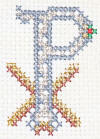 Handmade
Christmas Tree Ornaments have been popular since the first Christmas
Trees were used in sixteenth century Europe. A fairly recent
innovation to this practice in the last half century is to use various traditional symbols of the
Christian Faith as the motif of the ornaments. Some of the
traditional symbols of Christianity are monograms composed of various
combinations of letters of the name Christ or titles for Jesus. They are sometimes called Christograms
or Chrismons™. An early example is the Chi-Rho
monogram, composed of the first two letters in Greek of the word
Christos (Gk: chi, X = ch; rho, P = r). Handmade
Christmas Tree Ornaments have been popular since the first Christmas
Trees were used in sixteenth century Europe. A fairly recent
innovation to this practice in the last half century is to use various traditional symbols of the
Christian Faith as the motif of the ornaments. Some of the
traditional symbols of Christianity are monograms composed of various
combinations of letters of the name Christ or titles for Jesus. They are sometimes called Christograms
or Chrismons™. An early example is the Chi-Rho
monogram, composed of the first two letters in Greek of the word
Christos (Gk: chi, X = ch; rho, P = r).
These monograms and other symbols, such as the sign
of the fish, were in use early in the first centuries of the church as secret symbols of
Christianity. However, the symbols became popular in the fourth century AD
when the Roman emperor Constantine, after his conversion to
Christianity, adapted the Chi-Rho monogram as his military ensign.
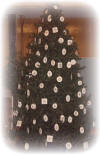 These
ornaments
are a creative way to use these ancient symbols at
Christmas. The practice of creating
and using the ornaments has spread and is becoming an increasingly popular
way for families and churches to retain a sense of the sacred amid the
secularization of this important Christian holiday. These
ornaments
are a creative way to use these ancient symbols at
Christmas. The practice of creating
and using the ornaments has spread and is becoming an increasingly popular
way for families and churches to retain a sense of the sacred amid the
secularization of this important Christian holiday.
Not only are the ornaments made by individuals for personal or
family Christmas Trees, increasingly they are community projects.
In many cases, a church will have a Christmas Tree in which members of the congregation make the
symbol ornaments for the tree. In some churches, this
is combined with the Jesse Tree, and becomes
a project for the children of the church during the entire season of
Advent.
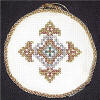 The primary
colors of the ornaments should be the liturgical colors of Christmas, white (or silver)
and gold (see The Colors of the Church Year).
Beyond that, they can be made from a variety of materials with a range
of traditional Christian symbols limited only by the creativity of the
person making them. The cross stitch examples
pictured here were made by both Catholic and Protestant members of the
Hill Air Force Base Chapel, Layton Utah, for the Base Chapel’s Christmas
Tree. The primary
colors of the ornaments should be the liturgical colors of Christmas, white (or silver)
and gold (see The Colors of the Church Year).
Beyond that, they can be made from a variety of materials with a range
of traditional Christian symbols limited only by the creativity of the
person making them. The cross stitch examples
pictured here were made by both Catholic and Protestant members of the
Hill Air Force Base Chapel, Layton Utah, for the Base Chapel’s Christmas
Tree.
Pictured below are only a small selection of the
symbols that can be incorporated into these ornaments (click images for
larger graphic).
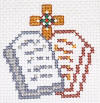 |
The ten commandments with a cross, representing the
continuity of the Old and New Testaments as well as Jesus'
fulfillment of the "law." |
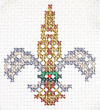 |
The fleur-de-lis is a stylized lily. It represents purity
and so symbolizes the Virgin Mary. Because of its three points,
it can also symbolize the Trinity and the
resurrection. In France, it came to
represent royalty. |
 |
The lyre or harp is associated with David as a shepherd boy,
and so represents praise to God. It symbolizes the angelic
chorus who sang praises to the shepherds at the birth of Jesus. |
 |
A single white candle symbolizes the Christ. The
golden glow of the candle recalls the halo of light called a
nimbus that symbolized divinity and power in
medieval paintings. |
 |
The eight pointed Armenian Star, the points symbolizing Christ; in the west, it is
also called the Bethlehem Star, symbolizing the world Jesus came to
save; eight is the symbol of newness, often associated with baptism or resurrection. |
 |
The Star of David or the Creator's Star. The six points
represent six aspects of God: love, mercy, wisdom,
majesty, power, and justice. In this form, the two triangles
represent the Trinity. |
 |
A four-pointed silver Natal Star or Bethlehem Star symbolizing
the birth of Jesus; the second set of gold rays form the Greek
letter X (chi), the first letter of the title
Christos, Christ, in Greek. |
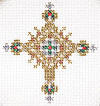 |
A Natal Cross, with a four-pointed Bethlehem Star representing the sign in the
night sky announcing Jesus' birth combined with a cross,
symbolizing the salvation which the birth of this child brings. |
 |
A King's Crown is the symbol of royal power and authority. It
symbolizes Jesus as King of the Jews, in fulfillment of
prophetic expectation, as well as the exalted Christ as King of
Kings. |
 |
A variation of the ducal or Prince's Crown, symbolizes Jesus
as the Son of God and Prince of Peace. |
 |
The Chi-Rho monogram, composed of the first two letters in
Greek of the word Christos (Gk: chi, X = ch; rho, P = r). There are many variations of
this monogram. |
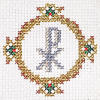 |
A variation of the Chi-Rho monogram. |
 |
A form of the
triquetra, a symbol of the Trinity from
Great Britain. The three points represent Father, Son, and
Holy Spirit while the continuous interwoven line represents
unity. |
 |
A combination of a triangle and the trefoil, a
stylized shamrock used by St. Patrick to illustrate the Trinity.
Both are symbols of the Trinity, three persons united in One. |
 |
The dove is a symbol of the Holy Spirit, recalling the
Holy Spirit's descent on Jesus as a dove at his Baptism.
The nimbus, three-pointed rays around its head, is a
symbol of the Trinity. |
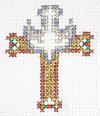 |
The cross combined with a dove symbolizes the empowerment of
the Holy Spirit for mission and ministry, as recounted in Luke:
"Jesus, filled with the power of the Spirit" (4:14). |
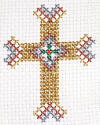 |
The Armenian Cross, a pre-Christian icon adapted by Armenian
Christians; the number eight was sacred and the eight points
came to symbolize Christ. In heraldry, called a Forché (forked)
Cross. |
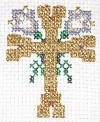 |
A form of the Armenian Cross; the lilies symbolize the
resurrection and hope; the eight points represent Christ and
salvation, as well as the proclamation of the Gospel message to
all eight points of the compass. |
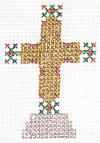 |
A Calvary Cross with steps symbolizing the site of Jesus'
crucifixion. Also known as the Graded Cross, with the
steps representing the virtues of faith, hope, and love. The
budded arms symbolize the resurrection and hope. |
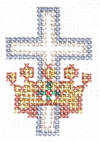 |
The Cross and Crown is an ancient symbol of the humiliation
and exaltation of Jesus as the Christ. It symbolizes the
suffering and death of Jesus as well as his final victory over
sin and death. |
 |
A variation of the
Fleurée or Fleur-de-lis Cross with the
arms ending in stylized lilies; the three-petaled arms of the
cross symbolize the Trinity; the lily also symbolizes the
resurrection. |
 |
A Greek
Fleurée Cross or Gothic Cross, whose open petals
symbolize the mature Christian; the three petals on each
arm symbolize the Trinity, while the open flowers speak of new
life and the resurrection. |
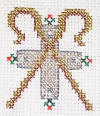 |
A cross combined with the shepherd's crook symbolizes Jesus
as the Good Shepherd who will lay down his life for others; the
two crooks together form a X (chi), the first letter of the title
Christos, Christ, in Greek. |
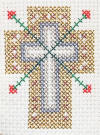 |
A variation of the cross with a X (chi), the first letter of the title
Christos, Christ, in Greek. |
 |
An Avellane Cross with arms resembling filberts or
hazelnuts; used in 18th century English coats of arms and as an
heraldry symbol; the three points on the arms symbolize the
Trinity and the resurrection. |
 |
A modern symbol known as "The
Love of God Cross," recalls the words of John 3:16. It
symbolizes the love of God for us revealed in the entire life of
Jesus as proclaimed in the four Gospels. |
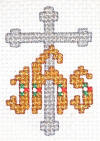 |
The IHS monogram or Christogram is composed of the first
three letters of the name Jesus in Greek. Here it is combined
with the Budded or Trefoil Cross symbolizing the Trinity.
Together this symbolizes the divinity of Jesus. |
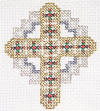 |
Reminiscent of a Celtic Cross, the circle, since it has no
beginning or end symbolizes eternity and so
represents God; in this combination, it symbolizes the endless
love of God offered through Jesus and his death on the Cross. |
 |
A stylized version of the Crusader's or Jerusalem Cross. It
symbolizes the Four Gospels or the spread of the Gospel to the
four corners of the Earth. The five crosses can also
represent the five wounds of Jesus. |
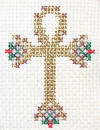 |
A variation of the Ankh Cross, an ancient Egyptian symbol
adopted by Christians to symbolize eternal life; the budded arms
symbolize the resurrection and hope. |
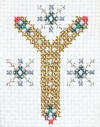 |
The Furca (forked)
or Upsilon Cross (from the Greek letter Y) is also called The
Thieves' Cross from the two robbers who were crucified on each
side of Jesus. From ancient times, the furca symbolized the choice between
good and evil.
|
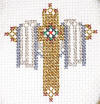 |
The Cross draped in white/silver is a symbol of the
resurrection and Jesus' victory over sin and death. |
 |
A variation of the Gamma Cross (the arms resemble the
Greek letter
G )
or wheel cross, symbolizing the power of God working in
redemption. The four gammas also represent the four Gospels that
proclaim redemption. |
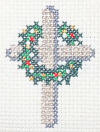 |
A cross with a wreath, an ancient symbol of victory, here
symbolizing Jesus' victory over sin and death. The greenery of
the Christmas wreath connects the cross with Jesus' birth; the
circle symbolizes eternity and eternal life. |
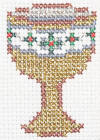 |
The cup symbolizing the sacrament of Eucharist or Communion;
it also represents forgiveness and reconciliation with God. |
 |
A stylized head of wheat symbolizing the bread of Eucharist
or Communion. It also recalls Jesus as the Bread of Life (Jn
6:35, 48), and can also represent the Church among the "weeds"
of the world. |
 |
The Greek letters alpha (first) and
omega
(last) from
Rev 1:8 and 22:13, symbolizing Jesus as the Christ who has come
and will come again; it also symbolizes the continuity of God's
presence in human history. |
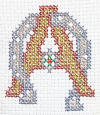 |
A variation of the alpha and omega symbol for Jesus the
Christ. |
 |
The first letter In Greek of
several titles of Jesus (Jesus, Christ, Son of God, Savior) together spell the Greek word for fish (icquV,
ichthus). This fish symbol incorporates the
chi-rho monogram. |
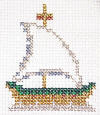 |
A ship symbolizes the church as the "ark of salvation" that
carries people to safety. It recalls the story of Noah and the
flood, as well as Jesus' calming the storm and saving the
disciples. |
 |
The wreath is an ancient symbol of victory. It symbolizes
the victory of Jesus over sin and death. The circle also
symbolizes eternity and eternal life. |
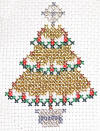 |
The decorated and lighted Christmas Tree came into general
use in Germany during the Reformation, and symbolized the
brightness, beauty, and joy of the Christmas season as a time to
celebrate God's grace. |
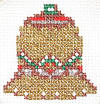 |
The bell is a later western symbol that arose from church
bells calling people to worship. It represents the
proclamation of the Gospel to the world. |
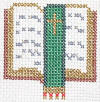 |
A symbol of the Bible and the word of God spoken through
Scripture. The open Bible symbolizes the truth and
revelation of God. |
 |
The seashell or scallop is a symbol for Christian baptism or
the baptism of Jesus. It is also a symbol for pilgrimage and the
spread of the Gospel to the world. |
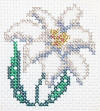 |
A stylized white poinsettia, a modern symbol of the
Christmas season. |
|
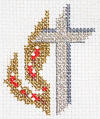 |
The Cross represents Christ and the flame is a reminder of
Pentecost when diverse witnesses were unified by the power of
the Holy Spirit. The Cross and Flame* is the official symbol of
the United Methodist Church.* |
|
|
Chrismon™ is a registered trademark of
Ascension Lutheran Church, Danville VA
The designs of these ornaments are copyrighted by Designing Women, Inc.,
from the book Fifty-Five Christian
Symbols, and are used by
permission. The text and photographs on this page are
Copyright ©
2018, Dennis Bratcher
and CRI/Voice, Institute -
All Rights Reserved.
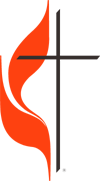 *The
Cross and Flame is a registered trademark and is used by permission.
Its use is supervised by the General Council on Finance and
Administration of
The
United Methodist Church. Permission to use the Cross and Flame must
be obtained from the General Council on Finance and Administration of
The United Methodist Church - Legal Department, 1000 17th Avenue South,
Nashville, TN 37212. *The
Cross and Flame is a registered trademark and is used by permission.
Its use is supervised by the General Council on Finance and
Administration of
The
United Methodist Church. Permission to use the Cross and Flame must
be obtained from the General Council on Finance and Administration of
The United Methodist Church - Legal Department, 1000 17th Avenue South,
Nashville, TN 37212.
-Dennis Bratcher, Copyright ©
2018, Dennis Bratcher -
All Rights Reserved
See Copyright and User Information
Notice
|
|
Christian Symbols
Christmas Tree Ornaments
|
Related pages
Advent
Advent Readings
The Jesse Tree
The
Church Year
Colors of Church Year
Christmas
Christmas Readings
12 Days of Christmas
Services for
Advent and Christmas:
Hanging of the Green - Traditional
Hanging
of the Green - Liturgical
A Service of the Nativity
The ornaments pictured on this page were made from the pattern book Fifty-Five Christian
Symbols. The designs are copyrighted by Designing Women, Inc.,
and are used here by permission. The book is distributed by Hoffman Distribution Company,
Inc., and can be ordered from various online stores. |

